When we talk about productivity, we generally focus on things like time management, prioritisation, procrastination, goal planning and the like. But there are some small, unexpected things you can do to dramatically improve your efficiency and output.
For the last few years, I’ve noticed that a lot of the clients and customers that I’ve come into contact with are terrible at using a computer. They’re really smart people, running successful businesses and doing great work. But I cringe when I see how long it takes them to do simple things on the computer.
Just last week, I was on a call sharing my screen and a client was watching me work. Later they turned around and said they couldn’t believe how fast I was able to get things done. The client said: “I have no idea what you just did, but that was cool!”
“Strategic productivity” (time management, planning etc.) helps us decide what to work on and how to spend our time. But “tactical productivity” (what tools to use and how to use them) helps us to execute on the strategic stuff in a more efficient way. And that’s what I’d like to talk about today.
Below, I’ve put together a list of often overlooked things you can do to boost your productivity. I say they’re overlooked because they’re things that people may hear about, but don’t put any effort into because they seem less important than the strategic things like time management. But when you get really good at the tactical things, you’ll be amazed at how fast you can get stuff done.
Don't want to read this post, listen to the podcast, or watch my video instead:
[youtube https://www.youtube.com/watch?v=ulmxix3-Tks]
1. Use a monitor
Over the last 6 weeks, I’ve been travelling and working on my 13” MacBook Pro. When we arrived home and I was able to plug into my external monitor, I was so relieved to finally have the extra screen real estate again. I have desks at a co-working space and at home. In both places, I have an external monitor that I can plug into.
The main benefit is that you can see more of your work at once. For example, I can see more of my task list and projects. I can see more deals and information on the screen when using Pipedrive. To illustrate what I mean, here’s a screenshot of what I can see in Asana when I’m just using a Laptop.
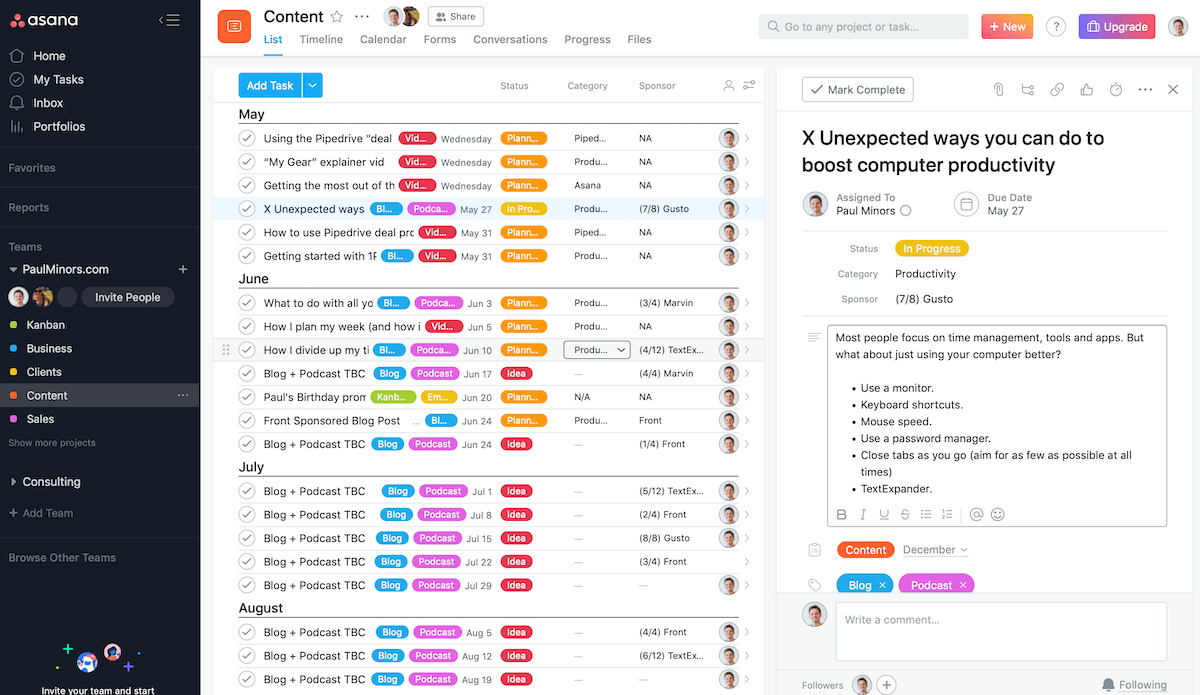
And here’s the exact same screen when plugged into a monitor.
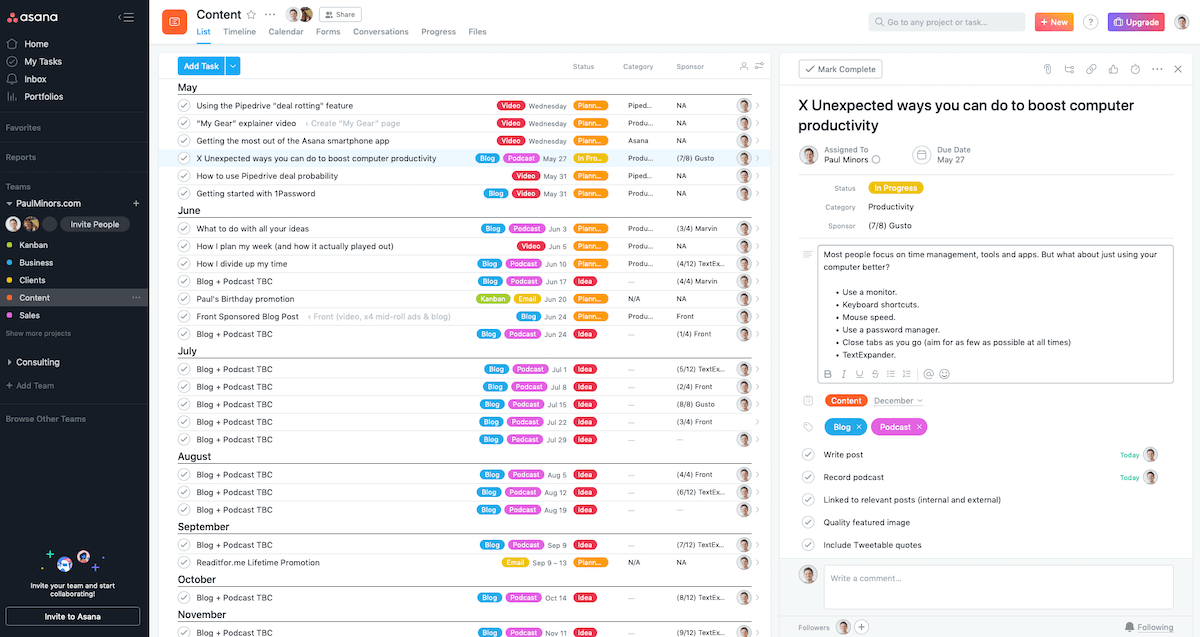
As you can see, there’s more information on the screen which means less scrolling around to manage my tasks.
I run most of my apps full-screen (rather than using two apps side-by-side) to help me focus on one thing at a time. But occasionally, I will run two apps in a split screen view if I need tools at once.
“Strategic productivity” (time management, planning etc.) helps us decide what to work on and how to spend our time. But “tactical productivity” (what tools to use and how to use them) helps us to execute on the strategic stuff in a more efficient way.Click To Tweet2. Learn as many keyboard shortcuts as you can
I can’t emphasise this one enough and is probably the most effective way to speed up your workflow on the computer. Learning shortcuts for navigating your computer and for the different tools you use can have a massive impact on your overall efficiency.
When I’m working on my computer, my goal is to do as much as possible without touching the mouse as I can. It’s generally a lot quicker to use a shortcut than it is to move a mouse around the screen, clicking a menu and select different options.
Whether you work on a Mac or PC, here are the different types of shortcuts you should be using:
- Navigation » Learn how to switch between apps and move between spaces. Learn how to move between files and folders and search for things on the web or in your documents.
- App-specific shortcuts » For your main tools like email, your task list, writing etc. learn the primary shortcuts for doing your work. e.g. creating a new email, sending an email, searching for email.
- Formatting shortcuts » Besides bold and underline, when writing text, learn how to insert bulleted or numbered lists, indent and change text formats.
- Moving your cursor » Did you know, you can actually select text and move your cursor between words, sentences and paragraphs using the keyboard? On the Mac, you can use the arrow keys and hold the option key to move between words or the command key to move to the beginning or end of a line. And if you hold shift while doing any of this, you can select text at the same time. When you learn these basic moves, you’ll be amazed at how your use of the mouse will go down.
Keyboard shortcuts come with a bit of a learning curve. My advice is to try and force yourself not to touch the mouse and if there’s something you’re trying to do, look to see if there’s a shortcut. For options in the menu, it’ll even tell you the available shortcut. After a week or so you’ll start to notice improvements in your efficiency.
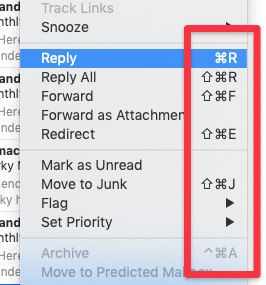
On the Mac, you can even customise your own shortcuts from “System Preferences » Keyboard » Shortcuts”. For example, I’ve created shortcuts to add a bullet list in Notes and Mail using the shortcut Shift + Cmd + U.
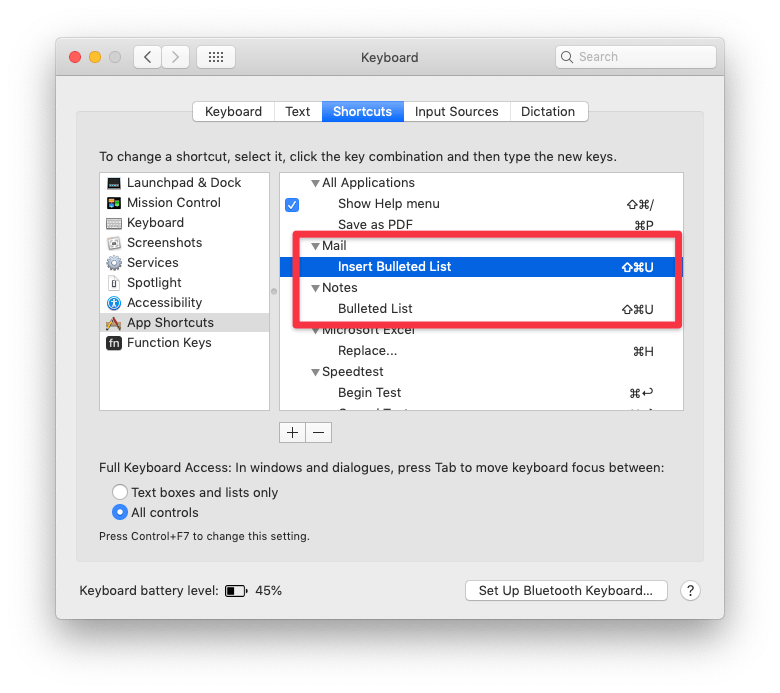
3. Maximise your mouse speed
As I mentioned above, the goal is to use as many shortcuts as you can to minimise your mouse usage. But when you do need to use the mouse, it’s good if you can have it set to move nice and quickly. This is a tip I picked up from Noah Kagan when he was interviewed for Tim Ferriss’s podcast.
On the Mac, I set my mouse to the maximum speed but this still wasn’t enough. You can use this little hack to make the mouse go even faster, beyond what the System Preferences will allow.
I’ve shared this tip with lots of people and always hear the same thing in response – The new mouse speed is surprising at first but you adapt to the new mouse speed very quickly (within an hour).
Speeding up your mouse simply means you can move around and click things without your hand having to travel as far. This actually puts less stress on your hand which is great if you suffer from repetitive strain injuries.
4. Use a password manager
Password managers like 1Password are great to have for helping to improve your online security but they also come with added productivity benefits.
I can’t tell you how much of my time spent with clients has been wasted due to password failures. Most people have a variation of the same password they use for most services but often forget which version is for which website. This usually results in a password reset taking place.
Using an app like 1Password, I can have strong unique passwords for everything and it’s actually quicker to login compared to typing a password manually. Using the Cmd + keyboard shortcut (see tip #2) I can quickly search my passwords and fill login forms. It'll even copy 2-factor codes to the clipboard so I can quickly login without having to wait for a text message. In fact, using 1Password you can search for a website and use the “Open and Fill” option to quickly open a new tab and login to your chosen account all with one click.
5. Keep your tabs to a minimum
All too often, when I’m viewing someone’s screen, I see dozens of tabs open in their browser. This is mind-boggling. Not only does this slow down your browser but I have no idea how people keep track of this many tabs or even why you need that many tabs open at once.
My tab philosophy is to minimise tabs as I go and keep them to an absolute minimum (besides Asana and Pipedrive which usually stay open all day). So as I’m working, I’ll open multiple tabs to get access to the pages and sites that I need. But just like when you’re driving and you check your mirrors every few seconds, I’ll glance up at my tabs and close the pages I no longer need (using the Cmd + W shortcut). And if you accidentally close something you’re still using, Cmd + Shift + T allows you to restore the last tab that you closed.
This helps you to maintain focus, be more organised and minimise distractions.
6. Increase typing efficiency with TextExpander
No surprises here… TextExpander (affiliate link) is a tool you’ve probably hear me talk about numerous times. To learn more about how I use TextExpander, check out this blog post and video.
TextExpander is an incredible tool that allows you to store text that you may want to type on a regular basis. You then type a snippet into any app you’re using and TextExpander spits out the text you’d like to use.
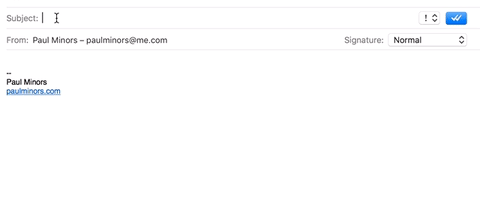
I use it dozens of times a day for things like email templates, links and filling forms with my address and contact information.
They even send you a report at the end of each month telling you how much time you saved based on the average typing speed. Last month I saved over 4 hours just on typing!
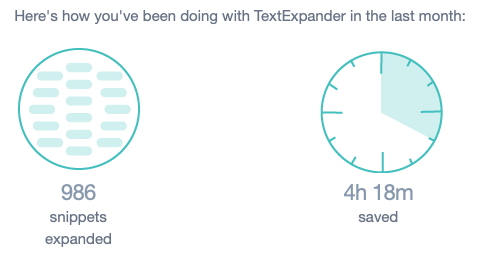
7. Use a clipboard manager
We copy text using Cmd + C dozens if not hundreds of times a day. But when you paste, you can only past the very last thing you copied.
A clipboard manager will remember the stuff you’ve recently copied so you can quickly search for and paste text and links that you copied hours, days or even months ago. This is extremely useful if I want to find a link or some text that I don’t have saved in TextExpander but that I know I’ve used recently.
I use the clipboard manager built into Alfred but there are loads of other good ones you can download as well. Using the keyboard shortcut Ctrl + Space, I can bring up the Alfred Clipboard manager from anywhere, type a word or phrase to find the text I need, then hit return to paste the copied text.
 If you're not doing any of the above, I highly recommend you start trying to include some of these tips into your workflow. If you have any of your own tips to share, please let me know in the comments below!
If you're not doing any of the above, I highly recommend you start trying to include some of these tips into your workflow. If you have any of your own tips to share, please let me know in the comments below!
